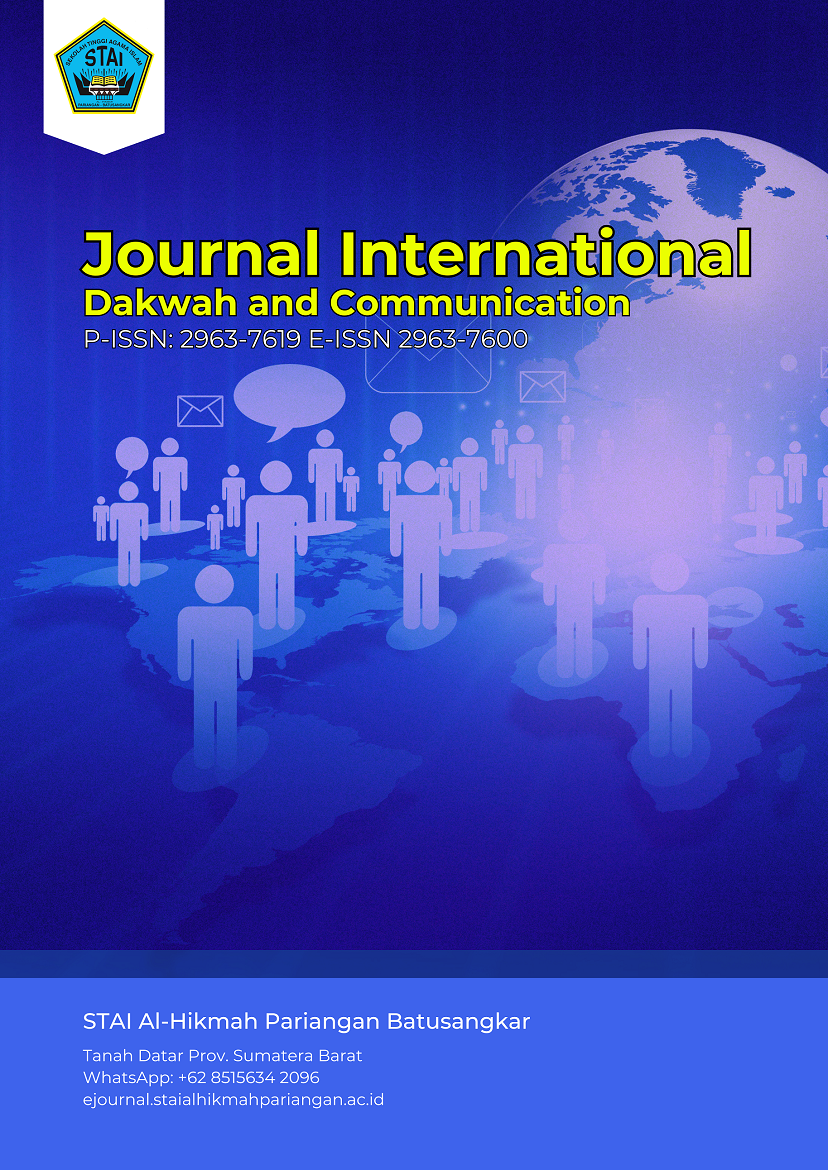The Effect of the Yanbu'a Method on the Ability to Read the Qur'an in Class VII Students of SMP Negeri 2 Jalancagak
Abstract
This research was motivated by students’ low abilities to read Al-qur’an in learning Islamic religious education lesson. This is because the learning strategies are not varied using the Al-Qur'an learning method so that students are not interested and have difficulty to read the Al-Qur'an. This study aims to determine the implementation of the yanbu'a method, the reality of the ability to read the Al-Qur’an and the influence of the yanbu'a method on the ability to read the Al-Qur’an in VII grade students at SMP Negeri 2 Jalancagak. The study used quantitative method to analyze the data with the pre-experimental design pattern, namely one group design pretest and posttest. The sample of the research were students of VII D class at SMP Negeri 2 Jalancagak. The results of the data yanbu'a method at SMP Negeri 2 Jalancagak was based on a calculation of 50.95% for the first meeting, 61.58% for the second meeting and 75.32% for the third meeting; and the reality value of the ability to read the Qur'an was 3.24, which means in the medium state. Evidently, It was obtainned that the effect of the yanbu'a method on students’ reading Qur’an ability of the normality test reached a significance value of 0.00 < of ? = 0.05, meaning that the data is not normally distributed. Consequently, a non-parametric test is used with the Wilcoxon test to find out the influence of using the yanbu'a method on students’ reading Qur’an ability, the results shows that the value of (2-tailed) = 0.00 < ? = 0.05, it means that Ho is accepted. There is a difference between the pretest and posttest of the use of yanbu’a method on students’ reading Qur’an Ability. It can be concluded that there was an effect of the yanbu'a method on the ability to read the Qur’an.
Full text article
References
Abdi, F. T., Muhammad, D. H., & Susandi, A. (2022). JPDK?: Volume 4 Nomor 1 Tahun 2022 Research & Learning in Primary Education Pendidikan Karakter ( Adab ) Ana k Perspektif Ibn Jama ’ ah Al - Syafi ’ i Dan Imam Al-Ghazali. 4, 139–148.
Alfath, K. (2020). Pendidikan Karakter Disiplin Santri Di Pondok Pesantren Al-Fatah Temboro. Al-Manar, 9(1), 125–164. https://doi.org/10.36668/jal.v9i1.136
Amrizal, M. A., Fuad, N., & Karnati, N. (2022). Jurnal basicedu. 6(3), 3602–3612.
Ardilah, N. (2021). Peran Kiai Dalam Pembinaan Akhlak Santri Di Pondok Pesantren. UIN Walisongo Semarang, 3(2), 20–21.
Ardilah, N., Anisa, R., Nurseha, A., Abdul, F., & Jauharudin, A. (2023). Implementasi Metode Yanbu ’ a Untuk Meningkatkan Hasil Belajar Baca Al- Qur ’ an di SMP Negeri 2 Jalancagak. 7, 21243–21248.
Arwani, M. U. (2004). Thoriqoh Baca Tulis dan Menghapal Al-Qur’an Yanbu’a Jilid 1. Pondok Tahfidh Yanbu’ul Qur’an Kudus.
Astuti, R. (2013). PENINGKATAN KEMAMPUAN MEMBACA AL-QURAN PADA ANAK ATTENTION DEFICIT DISORDER MELALUI METODE AL-BARQY BERBASIS APPLIED BEHAVIOR ANALYSIS PAUD PPs Universitas Negeri Jakarta Al-Quran beberapa huruf hijaiyah , sedangkan ( Attention ADD ( Attention Deficit Dis. Pendidikan Usia Dini, 7(2), 1–16.
Chaer, A. (2012). Al-Qur’an dan Ilmu Tajwid. Rineka Cipta.
Choliyah, S. A. (2015). Peningkatan Prestasi Belajar Membaca al- Qur ’ an dengan Metode Yanbu ’ a. 147–172. https://doi.org/10.18326/mudarrisa.v7i2.147-172
Fatah, A., & Hidayatullah, M. (2021). Penerapan Metode Yanbu’a dalam Meningkatkan Kefasihan Membaca Al Qur’an di Pondok Pesantren Darul Rachman Kudus. Jurnal Penelitian, 15(1), 169. https://doi.org/10.21043/jp.v15i1.10749
Feranina, T. M., & Komala, C. (2022). Sinergitas Peran Orang Tua dan Guru dalam Pendidikan Karakter Anak. Jurnal Perspektif, 6(1), 3. https://doi.org/DOI: http://dx.doi.org/10.15575/jp.v6i1.163
Gustin Rif’aturrofiqoh. (2016). Pengaruh Penggunaan Metode Yanbu’a Terhadap Kemampuan Membaca Al-Qur’an Pada Mata Pelajaran Al-Qur’an Pada Mata Pelajaran Al-Qur’an Hadits Kelas Iv Min 7 Bandar Lampung (Issue July).
Maryuliana, Subroto, I. M. I., & Haviana, S. F. C. (2016). Questionnaire Information System Measurement of the Need for Additional Learning Materials to Support Decision Making in High Schools Using a Likert Scale Skala. Jurnal Transistor Elektro Dan Informatika (TRANSISTOR EI), 1(2), 1–12. http://lppm-unissula.com/jurnal.unissula.ac.id/index.php/EI/article/download/829/680
Nuraeni, F., & Lubis, M. (2022). Pola Asuh Orang Tua dan Implikasinya Terhadap Pembentukan Karakter Anak. Jurnal Pendidikan Anak Usia Dini Undiksha, 10(1), 137–143. https://doi.org/10.23887/paud.v10i1.46054
Nurseha, A., Ardilah, N., Ruhdiyanto, D., & Wibowo, D. V. (2023). Penerapan Metode Yanbu’a dalam Pembelajaran Membaca Al-Qur’an pada Anak Usia Dini di TK An-Nur Cimalingping. JIIP - Jurnal Ilmiah Ilmu Pendidikan, 6(5), 3529–3536. https://doi.org/10.54371/jiip.v6i5.2015
Nurseha, A., & Syakir, F. (2023). IMPLEMENTASI NILAI-NILAI PENDIDIKAN AKHLAK ? ? ? ? ? ? ? ? ? ? ? ? ? ? ? ? ? ? ? ? ? ? ? ? ? ? ?. 1.
Pendidikan, A. P., & Islam, A. (n.d.). BAB III Pendidikan Agama Islam. 65–88.
Rahman, A. A. (2017). Penerapan Pendekatan Realistic Mathematic Education ( Rme ) Pada Materi Statistika untuk Meningkatkan Pemahaman Konsep dan Prestasi Belajar Siswa. Genta Mulia, 8(2), 1–12.
Rahmat. (2021). KAJIAN PEMBELAJARAN PKn MI / SD. Kajian Pembelajaran PKn MI, 1–121.
Zaim, M. (2019). Tujuan Pendidikan Islam Perspektif Al-Qur’an dan Hadits (Isu Dan Strategi Pengembangan Pendidikan Islam). Jurnal Muslim Heritage, 4(2), 14. https://doi.org/10.21154/muslimheritage.v4i2.1766
Authors
Copyright (c) 2024 Selvia Ru’yatus Saefullah, Novi Ardilah

This work is licensed under a Creative Commons Attribution-ShareAlike 4.0 International License.





